Question
Thale cress, Arabidopsis thaliana, is used to study the roles of genes and proteins in plants.
The cell membranes of the root hairs of A. thaliana contain proteins called aquaporins that
allow the movement of water between the soil and the cytoplasm as shown in Fig. 2.1.
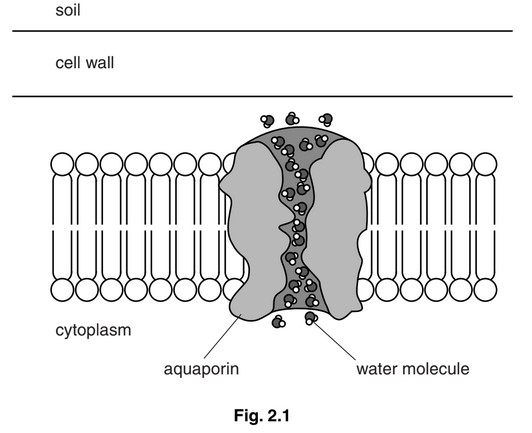
(a) With reference to Fig. 2.1:
(i) explain how water is absorbed by root hairs of A. thaliana
(ii) state why aquaporins are necessary in cell surface membranes.
(b) Describe the pathway taken by water from the cytoplasm of the root hair cell to a xylem
vessel in the centre of the root.
An investigation was carried out to find the effect of an enzyme in A. thaliana on the
composition of the cuticle. The enzyme is involved in the production of lipid that accumulates
in the cuticle.
Plants were discovered with a mutation of the gene that codes for the enzyme.
Some of these mutant plants (Group A) were grown in pots and their rate of transpiration
was determined over three days. They were compared with control plants (Group B) in which
the gene was switched on and the enzyme present. The results are shown in Fig. 2.2.
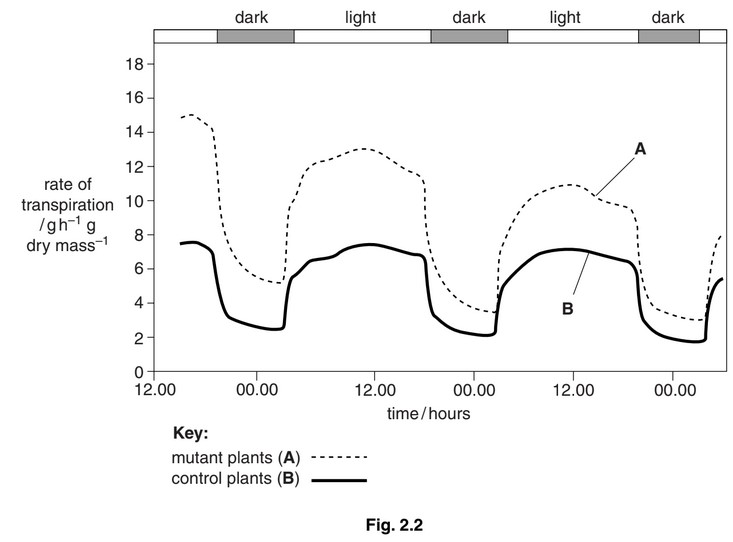
(c) With reference to Fig. 2.2, explain:
(i) why the rate of transpiration is higher during the day than at night in both groups of plants
(ii) how the results show that the cuticle is less effective in the mutant plants.
Answer/Explanation
Answer:
(a) (i) 1 diffusion through (freely permeable) cell wall;
2 membrane is partially permeable ; A selectively
3 osmosis across membrane (into cell)
4 (only) some water may pass between phospholipids (across membrane);
5 movement across membrane facilitated by aquaporins ;
6 ref. down water potential gradient / from high water potential to low water potential;
A from a higher / to a lower, water potential if in context
7 AVP ; e.g. further detail about aquaporin (hydrophilic channel)
(ii) 1 increases permeability of membrane to water ;
2 idea that osmosis across bilayer does not supply cell rapidly enough with water (that needs to pass on to surrounding cells) ;
3 idea that phospholipids are relatively impermeable to water ;
4 idea that water cannot pass / only some water passes, through hydrophobic
region of membrane / AW ;
(b) pathway via, cells of cortex / cortical cells, and endodermis / endodermal cells ;
symplast pathway, described as
cytoplasm and, plasmodesmata / vacuole(s) ;
(out of cell to) apoplast pathway, described as
cell wall pathway ;
Casparian strip / suberised cell wall, of endodermis, impermeable to water ;
(so) pathway only via, symplast / cytoplasm ;
AVP ; e.g. reference to pericycle
reference to passage cells of endodermis
vacuolar pathway (unless given in mp 2)
(c) (i) stomata are open (to absorb carbon dioxide for photosynthesis) ; ora
(ii) rate of transpiration, (almost) always / AW, higher / higher at night, in A / mutant
plants ; ora
A expressed in terms of water loss
at night only cuticular transpiration / no stomatal transpiration ;
idea that during day stomatal transpiration same for both ;
(so) differences because of less effective cuticle ;
comparative data quote ;
Question
Fig. 5.1 shows a section of a cell surface membrane.
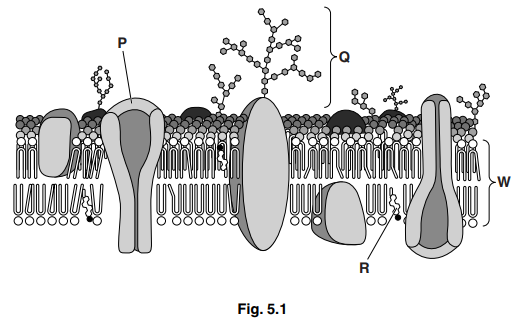
(a) State the functions of structures P, Q and R.[3]
P
Q
R
(b) Circle the width of the membrane shown as W in Fig. 5.1.
17.0 μm 1.7 μm 0.7 μm 70.0 nm 17.0 nm 7.0 nm 0.7 nm [1]
(c) Membranes, such as the cell surface membrane, are described as having a fluid mosaic structure.
Explain what is meant by the term fluid mosaic.[2]
(d) Aquaporins are membrane channel proteins in plant and animal cells. They permit the movement of water across membranes. Explain why they are necessary.[3] [Total: 9]
Answer/Explanation
Ans:
5 (a) P – moves, polar substances /hydrophilic molecules / ions, through membrane/ in or out (of cells) ;
A facilitated diffusion/ active transport/ described
Q – receptor/recognition site/ cell recognition/ binding site ;
A cell adhesion/ ‘receives’ named signal
A stabilises membrane (as forms hydrogen bonds with water)
R – regulates /AW, fluidity of, membrane/(phospholipid) bilayer ;
A contributes to hydrophobic layer/ impermeability to ions
(b) 7.0 nm ;
(c) fluid
idea of phospholipid (and protein) molecules, move about/ diffuse (within their monolayer) ;
mosaic to max 1
protein (molecules), interspersed/ scattered/not a complete layer/AW ; different/AW, proteins (molecules) ;
(d) 1 water molecules are polar ;
R hydrophilic / charged
2 idea that few polar molecules pass through the phospholipid (bilayer) ; ora for non-polar molecules
A none pass /repelled
3 core of membrane/ phospholipid tails, are hydrophobic ;
A hydrophobic core
4 channels (through aquaporins), are hydrophilic ;
A core of channel proteins /described as R-groups of amino acids
5 (aquaporins) increase permeability of membrane to water ;
6 example ;
e.g. root hairs / small intestine epithelium/ nephron
7 role of water in a cell ;
e.g. solvent /reactant/reaction medium/ turgidity or support in plant cell
ignore references to osmosis / bursting/ crenation/regulation
Question
(a) Table 2.1 shows eight ions that are biologically important.
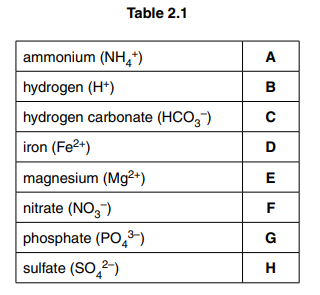
Choose one ion to match each of the following statements. In each case write one letter from Table 2.1. You may use each letter (A to H) once, more than once or not at all.
(i) A component of polynucleotides.[1]
(ii) Ion produced by enzyme activity inside red blood cells.[1]
(iii) Ion used in the production of all amino acids in chloroplasts.[1]
(iv) Ion that diffuses through carrier proteins with sucrose into companion cells in phloem tissue.[1]
(v) Component of haem group in haemoglobin that binds oxygen.[1]
(b) The enzyme nitrogenase is found in free-living and symbiotic nitrogen-fixing bacteria. Nitrogenase catalyses the reaction:
\(N_{2\left ( g \right )}+ 6 e^{-} + 8H^{+}_{\left ( aq \right )}\rightarrow 2NH{_{4}}^{+} {_{\left ( aq \right )}}\)
Some nitrogenase enzymes have vanadium ions in their active sites; others have molybdenum ions.
Explain how the enzyme nitrogenase functions in the fixation of nitrogen.[4]
(c) Some pea plants were grown with their roots in a solution of mineral ions. The solution was kept aerated for three days.
The concentrations of five ions in the solution and in the root tissue were determined after the three days. The results are shown in Table 2.2.
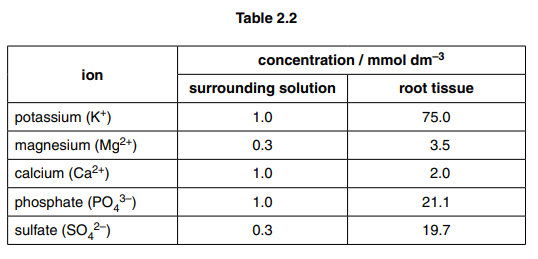
With reference to Table 2.2, suggest how cell surface membranes of root cells are responsible for the concentrations of ions in the roots compared to the surrounding solution.[5] [Total: 14]
Answer/Explanation
Ans:
2 (a) (i) G ;
(ii) B/C ;
(iii) A/F ;
(iv) B ;
(v) D ;
(b) 1 nitrogen and hydrogen/ substrates, bind to/AW, active site ;
2 enzyme-substrate complex (forms) ;
3 ref. lock and key / induced fit, mechanism ;
4 activation energy of reaction is lowered ;
5 example of how activation energy lowered ;
e.g. strain on (triple) bond of, N2 / (di)nitrogen
A bond broken between nitrogen (atoms)
nitrogen and hydrogen ions held close together for bond formation
transfer of electrons
alternative pathway
6 product/NH4+, leaves active site ;
7 ATP, required/ used/provided from respiration ;
8 ref. anaerobic conditions for enzyme action ;
9 suggestion as to use of, vanadium/ molybdenum, in active site ;
e.g. act as cofactor/ coenzyme
transfer of, electrons /protons
(c) 1 concentration of all the ions is greater in the root tissue than in the solution ; ora A roots
2 comparative data quote ;
according to these data
3 (so) ions will not diffuse into the root tissue ;
A if (facilitated) diffusion only, initially / till equilibrium reached
4 (so) active transport ; A active, uptake/ pumping I facilitated diffusion
5 use ATP ; A energy
R ATP energy
6 move ions, against concentration gradient/ from low to high concentration;
A diffusion gradient
7 use, membrane/ integral/ intrinsic / transmembrane/ transport/ carrier, proteins ;
R channel proteins
8 are specific / have specific binding sites ;
9 involve, conformational/ shape, change ;
10 comparative data quote to suggest that some ions are pumped more than others ;
e.g. steepest gradients for K+ and SO 4–
11 phospholipid bilayer/ hydrophobic core (of cell surface membrane) is impermeable to ions ;
12 so ions cannot diffuse out/(membrane) proteins only allow inward flow of ions ;
13 AVP ; e.g. suggestion of differing numbers of specific membrane proteins to explain observation of mp 10
